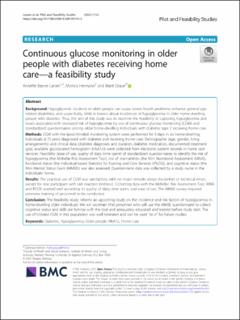| dc.contributor.author | Larsen, Annette Bævre | |
| dc.contributor.author | Hermann, Monica | |
| dc.contributor.author | Graue, Marit | |
| dc.date.accessioned | 2021-10-18T09:42:11Z | |
| dc.date.available | 2021-10-18T09:42:11Z | |
| dc.date.created | 2021-04-16T11:58:38Z | |
| dc.date.issued | 2021 | |
| dc.identifier.citation | Larsen, A. B., Hermann, M., & Graue, M. (2021). Continuous glucose monitoring in older people with diabetes receiving home care—a feasibility study. Pilot and Feasibility Studies. 7, 12. | en_US |
| dc.identifier.issn | 2055-5784 | |
| dc.identifier.uri | https://hdl.handle.net/11250/2823625 | |
| dc.description.abstract | Background
Hypoglycemic incidents in older people can cause severe health problems, enhance general age-related disabilities, and cause frailty. Little is known about incidences of hypoglycemia in older home-dwelling people with diabetes. Thus, the aim of this study was to examine the feasibility of capturing hypoglycemia and issues associated with increased risk of hypoglycemia by use of continuous glucose monitoring (CGM) and standardized questionnaires among older home-dwelling individuals with diabetes type 2 receiving home care.
Methods
CGM with the Ipro2-blinded monitoring system were performed for 5 days in six home-dwelling individuals ≥ 75 years diagnosed with diabetes and receiving home care. Demographic (age, gender, living arrangements) and clinical data (diabetes diagnoses and duration, diabetes medication, documented treatment goal, available glycosylated hemoglobin (HbA1c)) were collected from electronic patient records in home care services. Feasibility (ease of use, quality of data, time spent) of standardized questionnaires to identify the risk of hypoglycemia (the McKellar Risk Assessment Tool), risk of malnutrition (the Mini Nutritional Assessment (MNA)), functional status (the Individual-based Statistics for Nursing and Care Services (IPLOS)), and cognitive status (the Mini Mental Status Exam (MMSE)) was also assessed. Questionnaire data was collected by a study nurse in the individuals’ home.
Results
The practical use of CGM was satisfactory, with no major remarks about discomfort or technical errors, except for one participant with skin reaction (redness). Collecting data with the McKellar Risk Assessment Tool, MNA and IPLOS worked well according to quality of data, time spent, and ease of use. The MMSE survey required extensive training of personnel to be conducted.
Conclusion
The feasibility study informs an upcoming study on the incidence and risk factors of hypoglycemia in home-dwelling older individuals. We will ascertain that personnel who will use the MMSE questionnaire to collect cognitive status and skills are familiar with the tool and adequately educated and trained before study start. The use of blinded CGM in this population was well tolerated and can be used “as is” for future studies. | en_US |
| dc.language.iso | eng | en_US |
| dc.publisher | BMC | en_US |
| dc.rights | Navngivelse 4.0 Internasjonal | * |
| dc.rights.uri | http://creativecommons.org/licenses/by/4.0/deed.no | * |
| dc.title | Continuous glucose monitoring in older people with diabetes receiving home care—a feasibility study | en_US |
| dc.type | Peer reviewed | en_US |
| dc.type | Journal article | en_US |
| dc.description.version | publishedVersion | en_US |
| dc.rights.holder | © The Author(s) 2021 | en_US |
| dc.subject.nsi | VDP::Medisinske Fag: 700::Helsefag: 800 | en_US |
| dc.source.volume | 7 | en_US |
| dc.source.journal | BMC Pilot and Feasibility Studies | en_US |
| dc.identifier.doi | 10.1186/s40814-020-00754-3 | |
| dc.identifier.cristin | 1904554 | |
| dc.source.articlenumber | 12 | en_US |
| cristin.ispublished | true | |
| cristin.fulltext | original | |
| cristin.qualitycode | 1 | |

